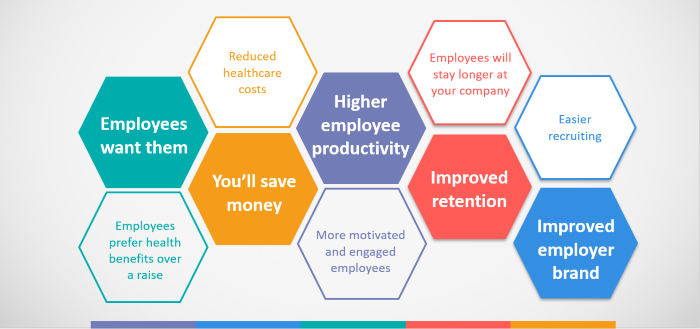When it comes to the health of your employees, you can never be too careful. Many experts believe that employee health should be a top priority for any business. After all, healthy employees are more productive and less likely to take time off work. Not to mention, investing in employee health can have some major benefits for your business! This article will discuss the importance of employee health and outline some of the benefits of investing in a good employee health program.
Understanding Employee Health Program In Brief

An employee health program is a set of policies and initiatives designed to promote the health and well-being of employees.
These programs can vary widely in scope but must include some combination of the following components:
- Education: Employees must receive education on maintaining a healthy lifestyle. This can be done through health awareness campaigns, educational materials, and presentations from health experts.
- Screenings and vaccinations: Employees should go through regular screenings and vaccinations to prevent serious health problems. These services should be easily accessible and affordable for employees.
- Fitness and wellness programs: Employees should be given opportunities to participate in fitness and wellness programs. These programs can help employees maintain a healthy weight, reduce stress levels, and improve overall physical health.
- Smoking cessation programs: Smoking is a major risk factor for many serious health conditions. Employees who smoke should be encouraged to quit through smoking cessation programs. These programs can provide support and resources to help employees quit smoking for good.
How Does Workplace Affect Wellness

The workplace has a significant impact on employee health. Poor working conditions can lead to stress, injuries, and illness. On the other hand, a healthy workplace can promote wellness and prevent disease. Some of the ways that the workplace affects employee health include:
- Workload: Employees who have a high workload are more likely to experience stress, which can lead to health problems.
- Working hours: Employees who work long hours are at a higher risk for burnout and illness.
- Physical environment: The physical environment of the workplace can impact employee health. Poor lighting, ventilation, and ergonomics can lead to eye strain, headaches, and musculoskeletal problems.
Types of Employee Health Programs
There are two main types of employee health programs: voluntary and mandatory.
- Voluntary programs are typically offered by employers as an incentive for employees to participate in healthy activities.
- Mandatory programs are usually required by law or company policy.
History and Development

The first employee health program was created in the early 20th century by the United States government. The program, known as the Civilian Conservation Corps, provided job training and education to young men during the Great Depression. In subsequent years, other countries would create similar programs to provide employment opportunities during periods of economic hardship.
In the 1970s, employee health programs began to focus on the prevention of disease and promotion of wellness. These programs had an aim to improve the health of employees and reduce the cost of healthcare for businesses. Today, employee health programs are an essential part of many businesses’ human resources strategies.
Listing Employee Health Program Benefits

There are many benefits of investing in an employee health program. Some of the most notable benefits include:
- Improved productivity: Healthy employees are more productive than unhealthy employees. This is due to both physical and mental health benefits.
- Reduced absenteeism: Healthy employees are less likely to take time off work due to illness or injury. This can lead to significant savings for businesses.
- Reduced healthcare costs: Healthy employees typically have lower healthcare costs than unhealthy employees. This is due to both the prevention of chronic diseases and the early detection of health problems.
- Improved morale: Healthy employees are typically happier and more engaged than their unhealthy counterparts. This can lead to a more positive workplace environment.
Data And Statistics

There is a growing body of evidence that supports the benefits of employee health programs. Some notable statistics include:
- Lower Medical Costs: A study by the American Journal of Health Promotion found that employees who participated in a wellness program had 26% lower medical costs and 20% lower absenteeism rates than those who did not participate.
- Reduced Absenteeism: A study by the Centers for Disease Control and Prevention found that employees who participated in a worksite health promotion program had a 28% reduction in sick days.
- Improved Productivity: A study by the Harvard Business Review found that employees who participated in a wellness program had a 13% increase in productivity.
Some Success Stories

Many companies have successfully implemented employee health programs. Some notable examples include:
- Google: Google’s “GoogleFit” program offers employees access to on-site fitness facilities, group fitness classes, and wellness seminars.
- IBM: IBM’s “OnSite Health Management” program offers employees on-site health clinics, fitness centers, and wellness coaching.
- Aetna: Aetna’s “Wellness Rewards” program offers employees discounts on gym memberships, fitness classes, and healthy food.
A Word From MantraCare Wellness
Employee wellness programs are the key to improving employee motivation, productivity, and retention. At MantraCare Wellness, we have a team of health experts, counselors, and coaches who serve corporate employees with 10+ wellbeing programs including EAP, Employee Diabetes Reversal, Corporate MSK, PCOS, Employee Fitness, Corporate Yoga, Employee meditation, and Employee Smoking Cessation.



